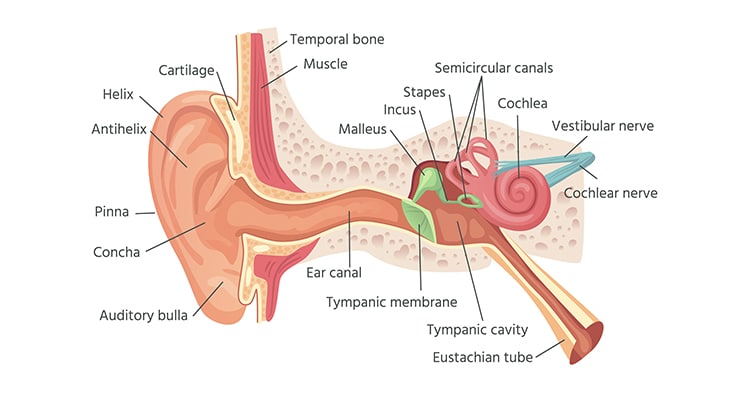Treating Patients With Hearing Impairment
Effective communication is essential in the dental setting for proper patient care and patient compliance.

Communication Is the Key
Effective communication is essential in the dental setting for proper patient care and patient compliance. Patients with hearing impairment face difficulty communicating, leading to an increased potential for social isolation and decreased quality of life. Communication can be a major challenge for dental hygienists, who must review patients’ medical histories, obtain informed consent, and provide oral health education. Under the Americans with Disabilities Act, dental providers are required to establish effective communication with individuals who are hearing impaired. These efforts must achieve the same level of communication required for hearing patients.
Photo Credit: agrobacter / E+

Types of Hearing Loss
Anatomic causes of hearing are typically associated with aberrations in the outer, middle, or inner ear, or a combination. There are four types of hearing loss: conductive, sensorineural, mixed, and central. Conductive hearing loss occurs when sound is not effectively conducted through the outer and middle ears to the inner ear. It is characterized by a decrease in sound volume and the inability to hear faint sounds. Typically caused by earwax, foreign body, or retained tissue fluid in the ear canal, conductive hearing loss may be related to allergies, ear infections, or poorly functioning Eustachian tubes. This type of hearing loss can generally be corrected with medication or surgery.
Photo Credit: Tetiana Lazunova / iStock / Getty Images Plus

Sensorineural Hearing Loss
Sensorineural hearing loss results from damage to the sensory hair cells in the inner ear or nerves that supply the inner ear. Patients with this type experience loss of volume and trouble discriminating between speech sounds. This hearing loss is permanent. Globally, the leading cause of sensorineural hearing loss is chronic ear infections; however, in the US, the most common etiology is presbycusis, or the gradual and progressive loss of hearing due to the aging process or noise damage. Other causes include disease or genetic syndromes, tumors, infectious diseases (eg, Rubella, meningitis), birth defects, or head trauma. Multiple medications can adversely affect the auditory system, including: aminoglycoside antimicrobials, chemotherapies, loop diuretics, aspirin, and anti-malarial agents. Systemic disease has also been linked to this type of hearing loss—namely hypertension, hyperlidemia, and diabetes mellitus (especially when diabetes is uncontrolled or in conjunction with smoking).
Photo Credit: xrender / iStock / Getty Images Plus

Mixed Hearing Loss
Mixed hearing loss is a combination of conductive and sensorineural hearing loss. Central hearing loss occurs when there is damage to the central nervous system that adversely affects nervous pathways to the brain. These include the effects of tumors, genetics, systemic diseases, or idiopathic factors. This type involves problems with identifying the location of sounds, discriminating between different sounds, inability to recognize auditory patterns, competing signals, or changes in tones and volumes. Because this type of hearing loss involves nerve damage, the condition is permanent.
Photo Credit: tampatra / iStock / Getty Images Plus

Improving Hearing
Several devices can help patients with mild to severe sensorineural hearing loss improve their hearing by magnifying or clarifying sounds or by enhancing sound conduction through the ear. Hearing aids are small electronic devices that amplify and shape sound waves before they enter the external ear. A hearing aid receives sounds, converts the sound waves to electrical signals, and sends them to a device that can amplify or otherwise modify sound signals destined for the ear. Although technological advances have resulted in smaller sized hearing aids and better sound qualities, only one in five patients who would benefit from a hearing aid has one. There are several styles of hearing aids, such as behind-the-ear, in-the-ear, and in-the-canal options.
Photo Credit: Rawpixel / iStock / Getty Images Plus

Oral Health and Hearing Loss
Poor oral health and pronounced gingival inflammation are common among adults with hearing impairments, thus raising their risk for caries and periodontitis. Adults with hearing impairment frequently report they do not understand how to prevent caries and periodontitis because of problems communicating with their oral health professionals. Auditory challenged adults also describe feelings of dental fear and anxiety.
Photo Credit: SIphotography / iStock / Getty Images Plus

Undiagnosed Hearing Loss
Slight to moderate hearing loss may go undiagnosed, especially in older adults. Oral health professionals should be aware of behaviors that may indicate a patient is having difficulty hearing, such as lack of attention and failure to respond to questions, strained facial expressions and staring when listening, turning head to one side, giving unexpected answers to questions or doing one thing when asked to do another, unusual speech quality or volume, frequent requests for the speaker to repeat what was said, and an inability to repeat information previously conveyed, such as oral hygiene instructions. Clinicians should be careful not to confuse a patient’s struggle to hear and communicate appropriately as disrespect, lack of interest, or impaired cognitive function.

